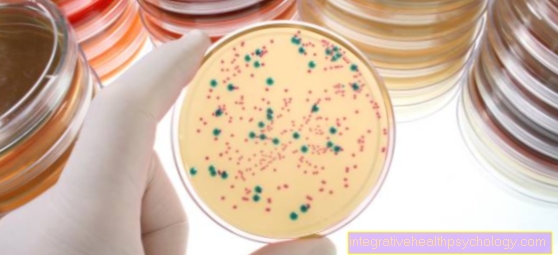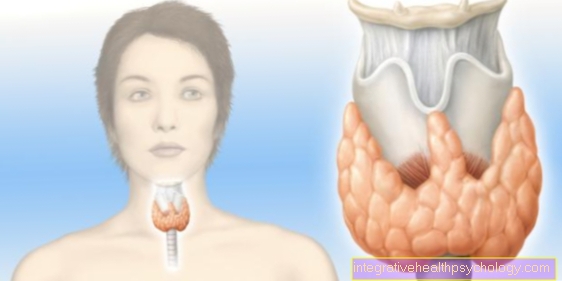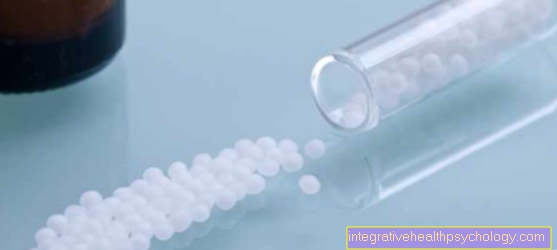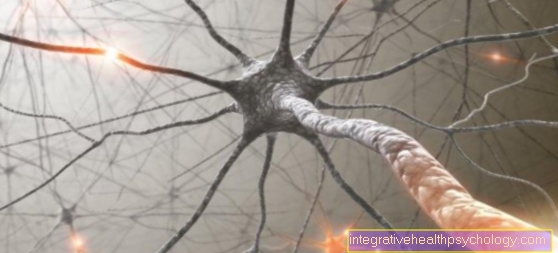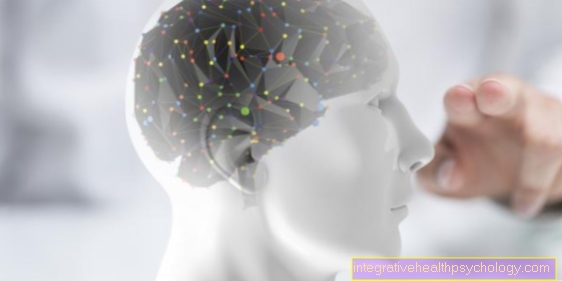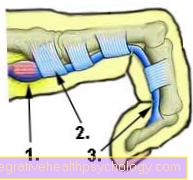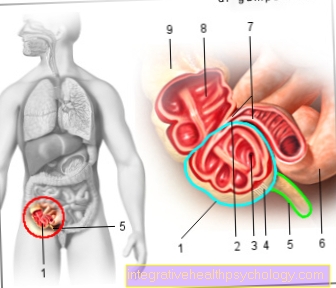Effect of alcohol - influence on the various organs
Introduction - How does alcohol affect people
As soon as we drink alcohol, it gets into the blood. A small part of the amount of alcohol is already absorbed through the oral mucous membrane and the mucous membrane of the esophagus and transported from there into the bloodstream. The rest of the alcohol is released into the blood through the stomach and intestinal mucosa (especially the small intestine).
The faster the alcohol gets into the blood, the faster the blood alcohol level rises and the faster you get "drunk". Once in the blood, the alcohol is distributed to all organs of the body. The lungs, kidneys and skin excrete up to 10% of alcohol, while the liver breaks down most of it.
Alcohol consumption affects the brain, liver and all other organs. Even the smallest doses of alcohol have an effect on the brain and, depending on the person and mood, can lead to increased talkativeness, mood and disinhibition. Alcohol can also cause irritation and aggressiveness in other people. If the blood alcohol level rises, speech and perception disorders occur. Affected people can become tired and drowsy. In the worst case scenario, alcohol poisoning can even lead to a life-threatening coma.
Read more about the topic here:
- Consequences of alcohol
- Alcohol withdrawal

Effect on the brain
Alcohol is a cell and nerve toxin. Short-term effects of alcohol are based on a disruption of the nerve cells in the central nervous system (brain and spinal cord). Alcohol is believed to be stored in membrane proteins in the cell walls and thus disrupts their function.
Ethanol (alcohol) mainly affects ion channels, i.e. proteins in the cell membrane that can be temporarily opened, for example to let certain substances in or out. Alcohol stimulates the so-called GABA receptors in the brain and blocks the NMDA receptors.
On the one hand, this causes an inhibition of the transmission of stimuli in the central nervous system and, on the other hand, an increase in sensitivity. This manipulation of the central nervous system affects the sense of balance and eyesight. Those affected suffer from a narrowed field of vision, the so-called "tunnel vision".
With a higher blood alcohol level due to larger amounts, alcohol has an acutely numbing effect and can cause memory loss. The cell toxin alcohol can trigger “programmed cell death” of developing brain cells, causing brain cells to die. This process is mainly triggered by so-called caspases. These are enzymes which, among other things, cause the cell death of the brain cells.
Heavy alcohol consumption increases emotionality, reduces mental performance and changes the perception of consciousness. Nausea and vomiting can be triggered. If alcohol is consumed in very large quantities for a short time, acute alcohol intoxication sets in. This means that the body is poisoned by ethanol (alcohol). Alcohol poisoning impairs the functioning of the brain, is toxic to the liver, impairs blood formation and is neurotoxic (as a nerve poison).
Alcohol poisoning can lead to circulatory failure or death from respiratory failure.
Alcohol is dangerous and can be harmful if used or consumed incorrectly. The development and effect of the alcohol depends on the amount you drink, the alcohol concentration of the drink and when and how much you ate beforehand.
In the short term, alcohol has different effects on the brain. In the long term, heavy consumption can cause serious changes in the brain, as alcohol affects the permeability of the blood-brain barrier.
The blood-brain barrier is a barrier between the bloodstream and the central nervous system, which is supposed to protect the brain from harmful substances. Long-term alcohol consumption can damage the blood-brain barrier. Chronic alcohol abuse can thus trigger behavioral neurological and inflammatory diseases in the brain. It also increases the susceptibility to bacterial infections.
Many people who suffer from chronic alcohol abuse often have a poor diet. Wernicke encephalopathy, a brain disorder due to vitamin deficiency, is therefore associated with alcohol abuse.
Another disease is Korsakoff's syndrome, in which brain structures that are responsible for memory and orientation die due to alcohol abuse.
You can find more information on the topic here:
- alcoholism
- Consequences of alcohol
Effect on the heart
The effects of alcohol consumption on the cardiovascular system have been discussed for decades. Many scientists believe that moderate alcohol consumption, up to a maximum of one glass of red wine a day, can lower the risk of cardiovascular disease. If you drink more, however, the risk of heart damage increases significantly.
Alcohol acutely increases blood pressure and thus affects the heartbeat. As a result, the heart beats faster than normal. This can lead to cardiac arrhythmias such as extrasystoles (additional heartbeats) and atrial fibrillation. Regular alcohol consumption can cause extrasystoles even in young people. These often go unnoticed and occur even in an otherwise healthy condition.
In the long term, the increased blood pressure can have a negative impact on the cardiovascular system. In alcoholics who consume a lot during the day, high blood pressure is often in need of treatment. Excessive alcohol consumption can favor diseases of the heart muscle and cardiac arrhythmias such as atrial fibrillation. In the worst case, alcohol abuse can even lead to sudden cardiac death.
Read more about: Palpitations after alcohol - is that dangerous?
Effect on the liver
The liver is 90% responsible for breaking down alcohol, and it suffers most from excessive consumption.
The liver breaks down alcohol in two phases with the help of liver enzymes.
- In the first phase, the alcohol is broken down by the enzyme alcohol dehydrogenase. A poisonous intermediate product is created: acetaldehyde. When alcohol is abused, acetaldehyde is responsible for damage throughout the body.
- In the second phase of alcohol degradation, acetaldehyde is converted into acetate (acetic acid). The acetic acid is further converted and introduced into the natural metabolism: the citric acid cycle, the fatty acid cycle and the synthesis of cholesterol.
With excessive alcohol consumption, therefore, more fatty acids are formed in the liver. This explains why alcohol abuse can lead to fatty liver disease.
If you consume too much alcohol, the body tries to adapt to the need and activates another enzyme, the “mixed-functional oxidase” (MEOS). This enzyme helps break down the alcohol into acetaldehyde more quickly. However, the resulting poison is not broken down any faster, instead it is present in the body in larger quantities. The acetaldehyde already damages the cell function of the liver cells in the short and medium term. In the long term, the accumulation of fatty acids in the liver leads to the formation of fatty liver.
Over time, the fatty liver can become inflamed, causing fatty liver hepatitis. This eventually leads to destruction of the liver lobules.
In the long term, cirrhosis of the liver (shrunken liver) develops. Due to the inflammatory processes in the liver, liver cells are replaced by functionless connective tissue, so that the liver can do its tasks less and less effectively. Liver cirrhosis is unfortunately irreversible and becomes life-threatening as it progresses.
Read more here:
- Alcohol breakdown
- Xarelto and alcohol
Effect on the kidneys
Alcohol affects the hormonal balance in the kidneys. By consuming alcohol, the production of the antidiuretic hormone (ADH, formerly vasopressin) is inhibited. The hormone is produced in the hypothalamus and fulfills regulatory tasks in the water balance.
ADH has an antidiuretic effect. This means that it causes water to be reabsorbed in the kidneys via water channels (aquaporins). This means that the body loses as little water as possible with the urine.
However, alcohol now inhibits the release of ADH. The consequence is that more water is excreted through the kidneys. This also explains why you often have to go to the bathroom when drinking alcohol.
Because of this effect of alcohol on the kidneys, dehydration (water loss) can occur. This explains the pronounced thirst that many people have the day after drinking, the so-called "post-thirst".
Effect on the gastrointestinal tract
About a quarter of the alcohol gets into the blood through the stomach lining, the majority through the small intestine. First of all, the alcohol in the gastrointestinal tract leads to increased blood flow. More products are formed in the stomach and intestinal walls, such as digestive enzymes and hydrochloric acid, which is found in large quantities in gastric juice. In the medium term, this leads to over-acidification in the stomach.
If alcohol is consumed in large quantities over a long period of time, acidification can cause complications. The body uses up the existing minerals in large quantities and ultimately falls back on the mineral deposits in the bones to meet its needs. If the bone metabolism is severely impaired, osteoporosis can develop.
In the long term, alcohol consumption is a strong irritant for the gastric mucosa and large amounts of gastric acid are produced. This often leads to acute gastric mucosal inflammation (gastritis). If you don't change your lifestyle and continue to drink alcohol regularly, the gastric mucosal inflammation can become chronic. Chronic gastritis increases the risk of developing a stomach ulcer.
Other sections of the intestine can also become inflamed. Acute intestinal inflammation can cause characteristic gastrointestinal complaints such as nausea, vomiting and diarrhea. In addition, the ability to digest food in the gastrointestinal tract is impaired in the long term.
Find out more about the topic here:
- Nausea after drinking alcohol
- Inflammation of the intestines
Effect on the oral mucosa
Some of the alcohol that is consumed enters the bloodstream directly from the lining of the mouth. If alcohol is consumed more frequently in large quantities, the oral mucosa can increasingly dry out. This makes the oral mucosa vulnerable to germs such as viruses, bacteria and fungi in the long term.
Alcohol increases the risk of inflammation of the oral mucosa (Stomatitis). Oral mucosal inflammation is associated with typical signs of inflammation, such as reddening, swelling, pain, loss of taste and possibly bleeding from the mucous membrane as well as bad breath, canker sores (painful damage to the oral mucosa) or ulcerations (ulcers).
In the long term, regular alcohol consumption in large quantities increases the risk of developing oral cancer. Excessive alcohol consumption (alcohol abuse) is said to increase the risk of developing oral cancer by thirty times.
Effect on the urinary bladder
Alcohol activates the sympathetic (sympathetic nervous system). This ensures that the bladder relaxes so it can fill up. When the pressure in the bladder increases significantly, the urge to go to the bathroom arises. The kidneys produce a lot of urine when alcohol is consumed and the urinary bladder fills up easily. This explains why you have to urinate frequently when drinking alcohol.
Effect on the testicles
Alcohol can have a negative effect on sexuality. When you consume alcohol, your blood levels of the sex hormone testosterone drop. As a result, nerve transmission from the brain to the erectile tissue of the penis is impaired and the erection is disturbed. In the long term, chronic alcohol consumption can lead to impotence and reduce libido.
Scientists say the testicle shrinks over time and men can become sterile. The alcohol also has a negative effect on the sperm and changes its shape so that it is less easy for them to penetrate the egg cells.
There are also cases in which chronic alcohol abuse in men leads to feminization due to hormonal changes. For example, fatty tissue can more easily attach to the hips and chest.
Read more on this topic: Erectile dysfunction


